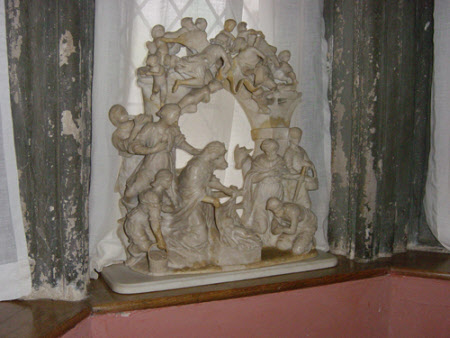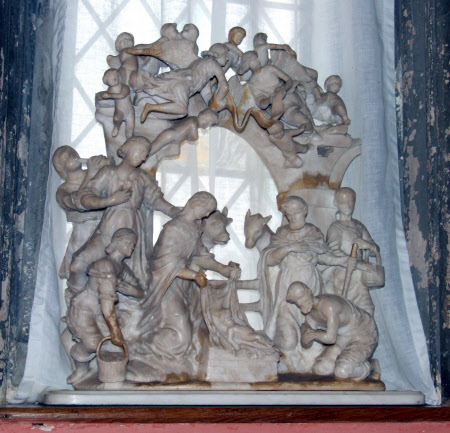The Adoration of the Shepherds
Sicilian (Trapanese) School
Category
Art / Sculpture
Date
c. 1650 - 1700
Materials
Alabaster and marble
Measurements
600 mm (H); 580 mm (W); 185 mm (D)
Place of origin
Trapani
Order this imageCollection
Oxburgh Hall, Norfolk
NT 1210493
Summary
Sculpture, alabaster; The Nativity with the Adoration of the Shepherds; Italy, Sicily, Trapani; c. 1650-1750. A sculpture carved in alabaster in Trapani, Sicily, c. 1650-1750, depicting the Nativity of Christ with the Shepherds, with Mary displaying the Christ Child to a crowd of astonished shepherds gathered around. The background is formed from a ruined arch above which fly rejoicing angels. Now mounted on a modern marble base. Previously thought to date from the 1800s and to have been made in Britain, this beautiful relief is in fact a remarkable work from the prolific alabaster workshops that flourished in the Sicilian city of Trapani from the sixteenth through to the late eighteenth centuries.
Full description
An alabaster sculpture depicting the Nativity with the Adoration of the Shepherds. The scene is set before a ruined arch. At left kneels the Virgin Mary with the infant Christ, placed on a swaddling sheet that has been laid upon a form of brick structure. Mary holds up the cloth to reveal Christ who is docile, his arms held out. A shepherd kneels and bows in homage before Christ, whilst behind him a bearded and cloaked man holding a staff, probably representing Joseph, touches his breast with his right hand in a gesture of humility. A younger shepherd, with a basket looped over his arm, stands behind them and likewise touches his breast. There are three more shepherds behind Mary; one plays on a shawm (an ancient woodwind instrument), a second holds a basket and kneels, his hand on his breast whilst the third seems to gesture with one hand on his breast in astonishment, whilst his left hand is (somewhat sacrilegiously) placed on the Virgin Mary’s neck. Behind the human figures, the ox and the ass lean inwards to join in the worship of Christ. Above the arch is a cluster of angels, at the front two older winged figures wearing drapery who hold a snaking banderole, which may once have had an inscription. Behind them is a crowd of small naked putti, some winged and some playing pipes, who whizz and gambol through the air. The sculpture is overall in very good condition, with little evidence of breakages. Remains of paint on the banderole but little sign that other areas were painted. It is mounted on a modern marble base with rounded edges at the front. Formerly though to have been made in Britain in the nineteenth century, the sculpture is in fact an outstanding product of the alabaster workshops that flourished in the city of Trapani in western Sicily, from the 16th until the early 19th centuries. These workshops produced enormous numbers of carvings using local stones, including the characteristic locally-mined form of red-veined stone known as alabastro rosa or pietra incarnata. The industry first developed in response to demand for small reproductions of a celebrated life-size marble statue of the Virgin and Child, said to have been given to the city of Trapani by a merchant in thanks for his deliverance from a storm. Housed in a dedicated chapel in the Basilica of Maria Santissima Annunziata, the Virgin of Trapani became a focus for devotion, with pilgrims from throughout the Mediterranean lands and beyond flocking to Trapani and creating a strong demand for small-sized transportable copies of the cult figure. The Jesuit Guglielmo Gumppenberg recorded in 1672 (Warren 2021, pp. 119-20) that there were around forty workshops in Trapani, in which the principal occupation was the production every year of around 5,000 small images of the Madonna of Trapani, mostly in alabaster (an example at Anglesey Abbey, NT 516604), but also in coral, an even more important material for the sculpture workshops in Trapani. Nativity scenes or presepi were among the most popular and best-known of the sculptural works of art produced from the seventeeth century in Sicily, especially Trapani. They were often created as elaborate tableaux with groups of tiny figures set within complex backdrops of landscapes and buildings, made usually not from alabaster but from materials such as coral, ivory, mother-of-pearl and metal. There is a good example at Compton Verney, whilst a very fine one in the Monastery de las Salesas Reales in Madrid is dated 1749 and signed by Andrea Tipa (Intorre 2022, fig. 1). Tipa is celebrated as among of the most important of the alabaster carvers, but he also worked in ivory and other materials, including here coral, silver, amber, hardstones. As hardly any Trapani alabaster sculptures are signed, attribution to individual makers, even the great names such as Andrea Tipa and his brother Alberto, are very difficult. Nativity scenes in alabaster are rather rare, but the three discussed in this entry all seem to derive from a peculiarly Sicilian prototype, with the Christ Child displayed between the standing or kneeling Virgin and Saint Joseph, and with the ox and the ass both playing active parts in the act of adoration. One early example of the general type is a fifteenth-century lunette in the church of Saint Mary of Bethlehem in Modica (Barricelli 1992, p. 39, fig. 2), but similar motifs are also seen in small-scale reliefs of the Nativity by the sculptor Francesco Laurana (c. 1430- before 1532) and members of the Gagini dynasty of sculptors, all of whom worked in Sicily. These scenes are sometimes found forming part of the base of Virgin and Child statues, for example, the relief of the Nativity on the base of the Madonna and Child group from the workshop of Francesco Laurana in the Cappella Mastrantonio in the Basilica di San Francesco d’Assisi in Palermo (Barricelli 1992, pp. 41-42, fig. 4; Kruft 1995, pp. 103-05, Figs. 83-84). Another such scene by Antonello Gagini (1478-1536) forms the base of the Virgin and Child of Divine Love figure in the church of S. Maria di Gesù in S. Piero Patti (Barricelli 1992, p. 45, fig. 9). As well as the Nativity at Oxburgh Hall, National Trust collections include another Trapani alabaster scene of the Nativity, at Anglesey Abbey (NT 516581; Warren 2021, pp. 128-29, fig. 14). It is much smaller than the Oxburgh relief, around half the size, but the format is very similar – the kneeling Virgin Mary at the left and Joseph at the right, with adoring shepherds on either side of them and, high in the air, a band of gambolling angels holding a banderole. Another closely related scene is the Nativity in the Museo Diocesano in Caltanisetta in central Sicily, on deposit from the church of the Anime Sante in Santa Caterina Villarmosa (Warren 2021, p. 129, fig. 15). This version, mounted on an elaborate carved alabaster base with a coat-of-arms in the middle, has no fewer than eight putti frolicking in the clouds. Other features that mark out these Nativities is the large space in the centre and the charming active participation of the ox and the ass in the adoration scene, which seems to be a particular characteristic of Nativity scenes made in Sicily. In the Anglesey Abbey and Caltanisetta Nativities, the animals actually kneel before the Christ Child who, in all three, is depicted lying full-length upon a cloth. The purpose of the opening in the middle of these scenes is not altogether clear; in the Anglesey Abbey and Caltanisetta scenes, there are also smaller deliberate holes in the groups of infant angels above. It may be that they were intended for the projection of some light source. The Oxburgh Hall Nativity is by far the largest of the currently known Trapani alabaster reliefs of the Nativity, and the most artistically accomplished, although there are in fact quite significant variations in quality between some of the individual figures. The larger foreground figures, the most important in the composition, are better conceived and carved than most of the child angels above. Overall, though, it is a very fine work, full of movement and life. In some respects, it comes close to an elaborate scene of Calvary with the Crucifixion currently on the art market, which is very unusually signed by a maker, Pietro Orlando (1651-1699), recorded in histories of Trapani as among the most important sculptors of his generation. Although there are not sufficient stylistic similarities to allow the Nativity to be attributed to Orlando, the work was probably made c. 1650-1700 by an artist in his workshop or circle. We do not know how the Nativity first came to Oxburgh Hall, but it was on display in the King’s Room until 1951, when virtually the entire contents of the house was sold. Together with other furniture and works of art the relief entered the collection of a local collector, Mr Bryan Hall of the Old Rectory, Banningham. The National Trust was able to buy back a number of objects for Oxburgh at Mr Hall’s sale in 2004, including the Nativity which today is once again on display in the King's Room. Jeremy Warren January 2025
Provenance
Oxburgh Hall, to 1951, when sold; Bryan Hall, The Old Rectory, Banningham, Norfolk; The Contents of the Old Rectory, Banningham, Norfolk, Bonhams, Banningham, 22-24 March 2004, lot 1148, £11,162; bought at the sale by the National Trust with funds provided by the Eastern Region and a private donor.
Makers and roles
Sicilian (Trapanese) School, sculptor British (English) School, sculptor
References
Barricelli 1992: Anna Barricelli, ‘L’Epifania nella scultura presepiale in Sicilia’ in M. Concetta Di Natale & V. Abbate, eds., In Epiphania Domini. L’adorazione dei Magi nell’arte siciliana, exh. cat., Cattedrale di Palermo, Palermo 1992, pp. 37-56 Kruft 1995: Hanno-Walter Kruft, Francesco Laurana. Ein Bildhauer der Frührenaissance, Munich 1995 Warren 2021: Jeremy Warren, ‘New perspectives on alabaster sculpture from Trapani‘, Colnaghi Studies Journal, Vol. 8 (March 2021), pp. 115-47 Intorre 2022: Sergio Intorre, ‘Il presepe di Andrea Tipa nel Monastero de las Salesas Reales’, in P. Palazzotto, G. Travagliato, M. Vitella, eds., Il Bello, l’Idea e la Forma. Studi in onore di Maria Concetta di Natale, Palermo 2022, I, pp. 191-96.

